Do you have a question about the Bajaj CT-100 and is the answer not in the manual?
Indicates potential hazard or injury if advice is not followed.
Indicates potential hazard that could result in vehicle damage.
Notes that descriptions are not binding; manufacturer reserves right to change.
Location of the alpha-numeric frame number on the steering tube.
Location of the alpha-numeric engine number on the crankcase.
Displays vehicle speed.
Records total distance traveled by the vehicle.
Lights up when the transmission is in neutral and ignition is ON.
Illuminates when the high beam is selected.
Flashes to indicate left or right turn signal activation.
Controls ignition and locks the steering handle.
Operates the fuel supply and secures the fuel tank.
Controls lights, horn, and turn signals.
Selects high or low beam headlights.
Activates left or right turn signals.
Activates the vehicle's horn.
Flashes the headlight to signal other vehicles.
Controls headlights and ride economy settings.
Manages headlight operation (On/Off, beam).
Senses throttle position for fuel economy.
Instructions for removing the left and right side covers.
Steps for correctly installing the side covers.
Identifies the location of the battery and tool kit.
Procedure for adjusting the front brake cable play.
Procedure for adjusting the rear brake pedal play.
Guidelines for the initial period of vehicle use for longevity.
Steps for starting the engine, including choke usage.
Instructions for starting from standstill and changing gears.
Guidance on applying brakes, including emergency braking.
Procedures for stopping, parking safely, and tips for fuel efficiency.
Covers wearing helmets, following rules, and safe driving.
Emphasizes simultaneous brake use and proper speed.
How to check and the capacity for engine oil.
Recommended oil grade, drain interval, and first replacement.
Location and cleaning schedule for the oil strainer.
Proper procedure for tyre work and recommended pressure.
Slackness adjustment, lubrication, and care.
Battery handling, disposal, and spark plug maintenance.
Tips for protecting the vehicle during rainy weather.
Essential checks for fuel, engine oil, throttle, steering, brakes, and lights.
Verifying drive chain, horn, steering, clutch, stands, tyres, and mirrors.
Steps to take when the vehicle is stored for over 15 days.
Proper removal and care of the battery when not in use.
Steps to recommission the vehicle after a period of non-use.
Indicates potential hazard or injury if advice is not followed.
Indicates potential hazard that could result in vehicle damage.
Notes that descriptions are not binding; manufacturer reserves right to change.
Location of the alpha-numeric frame number on the steering tube.
Location of the alpha-numeric engine number on the crankcase.
Displays vehicle speed.
Records total distance traveled by the vehicle.
Lights up when the transmission is in neutral and ignition is ON.
Illuminates when the high beam is selected.
Flashes to indicate left or right turn signal activation.
Controls ignition and locks the steering handle.
Operates the fuel supply and secures the fuel tank.
Controls lights, horn, and turn signals.
Selects high or low beam headlights.
Activates left or right turn signals.
Activates the vehicle's horn.
Flashes the headlight to signal other vehicles.
Controls headlights and ride economy settings.
Manages headlight operation (On/Off, beam).
Senses throttle position for fuel economy.
Instructions for removing the left and right side covers.
Steps for correctly installing the side covers.
Identifies the location of the battery and tool kit.
Procedure for adjusting the front brake cable play.
Procedure for adjusting the rear brake pedal play.
Guidelines for the initial period of vehicle use for longevity.
Steps for starting the engine, including choke usage.
Instructions for starting from standstill and changing gears.
Guidance on applying brakes, including emergency braking.
Procedures for stopping, parking safely, and tips for fuel efficiency.
Covers wearing helmets, following rules, and safe driving.
Emphasizes simultaneous brake use and proper speed.
How to check and the capacity for engine oil.
Recommended oil grade, drain interval, and first replacement.
Location and cleaning schedule for the oil strainer.
Proper procedure for tyre work and recommended pressure.
Slackness adjustment, lubrication, and care.
Battery handling, disposal, and spark plug maintenance.
Tips for protecting the vehicle during rainy weather.
Essential checks for fuel, engine oil, throttle, steering, brakes, and lights.
Verifying drive chain, horn, steering, clutch, stands, tyres, and mirrors.
Steps to take when the vehicle is stored for over 15 days.
Proper removal and care of the battery when not in use.
Steps to recommission the vehicle after a period of non-use.
| Displacement | 102 cc |
|---|---|
| Fuel System | Carburetor |
| Front Brake | Drum |
| Rear Brake | Drum |
| Fuel Tank Capacity | 10.5 liters |
| Starting Method | Kick Start |
| Tyre Size (Front) | 2.75 x 17 |
| Wheelbase | 1235 mm |
| Engine Type | 4 Stroke, Single Cylinder |
| Transmission | 4 Speed |
| Front Suspension | Telescopic |
| Tyre Size (Rear) | 3.00 x 17 |

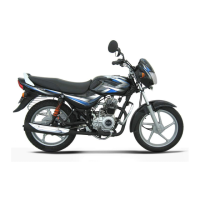




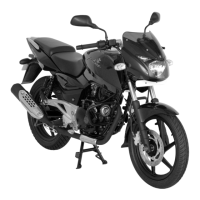
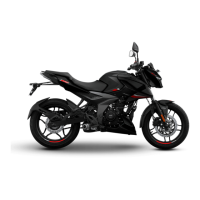
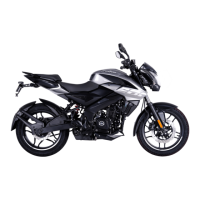

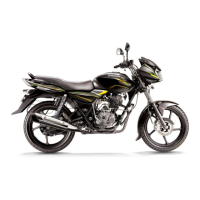

